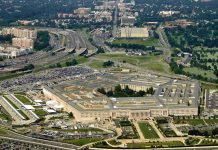
North Korean officials face imprisonment after a humiliating naval destroyer launch failure in front of Kim Jong Un, potentially signaling harsh consequences for those who embarrass the regime’s military ambitions.
Key Takeaways
- Four shipyard officials have been detained for “criminal negligence” following the capsizing of North Korea’s second naval destroyer during its launch ceremony
- Kim Jong Un publicly criticized military officials, scientists, and shipyard operators—a rare move that underscores his anger over the embarrassing military setback
- Satellite imagery revealed the vessel lying on its side and partially submerged despite North Korean claims of minimal damage
- The failed launch represents a significant setback to Kim’s naval modernization efforts aimed at countering perceived US threats
- North Korea’s reported 10-day repair timeline is being disputed by international observers who believe the damage is far more severe
Launch Ceremony Disaster Exposes Regime’s Military Vulnerabilities
North Korea’s military modernization efforts suffered a humiliating blow when its second naval destroyer capsized during a high-profile launch ceremony at the Chongjin Shipyard. The vessel, intended to showcase the regime’s growing naval capabilities, instead highlighted significant technical shortcomings when a transport cradle detached during the launch sequence. Satellite imagery subsequently captured the embarrassing aftermath: the warship lying on its side, partially submerged in water, and hastily covered with blue material in an apparent attempt to conceal the extent of the damage from aerial observation.
The failed launch represents a particularly acute embarrassment for Kim Jong Un, who has consistently emphasized naval modernization as a critical component of his military strategy against what North Korea perceives as American threats. This destroyer was meant to be a showcase of North Korean military industrial progress, demonstrating the regime’s ability to produce increasingly sophisticated vessels. Instead, the botched launch has revealed potential critical weaknesses in North Korean shipbuilding capabilities and quality control standards that may have broader implications for the country’s military readiness.
Kim’s Rare Public Criticism Signals Serious Consequences
In an unusual display of public anger, Kim Jong Un personally condemned those responsible for the failed launch in exceptionally harsh terms. The North Korean leader described the incident as a “criminal act caused by absolute carelessness, irresponsibility and unscientific empiricism,” said Kim Jong Un, Supreme Leader of North Korea. This direct attribution of blame represents a departure from typical North Korean state media practices, which rarely acknowledge failures of this magnitude—especially when they involve prestigious military projects tied closely to the regime’s strategic interests.
North Korea’s powerful Central Military Commission reinforced Kim’s condemnation, stating that those responsible “can never evade their responsibility for the crime,” according to North Korea’s powerful Central Military Commission.
The detention of four senior shipyard officials—including the chief engineer, head of hull construction, and deputy manager at Chongjin Shipyard—demonstrates the regime’s determination to assign blame for this public failure. These detentions serve dual purposes: providing scapegoats for the technical failure while simultaneously sending a clear message throughout the military-industrial complex that failures affecting the regime’s prestige will result in severe personal consequences. In North Korea’s system, such detentions can lead to lengthy imprisonment in harsh conditions or worse.
Damage Control and Military Implications
North Korean state media has attempted to downplay the incident, claiming the destroyer suffered only minor damage that could be repaired within ten days. However, international observers analyzing satellite imagery have disputed this characterization, suggesting the damage is significantly more extensive than officially acknowledged. The visible listing of the vessel and partial submersion indicate potential structural damage that would require substantial repairs, potentially delaying the destroyer’s entry into operational service by months or even longer.
This setback carries important implications for North Korea’s naval modernization program. The country has limited shipbuilding capacity, with Chongjin representing one of its few facilities capable of producing vessels of this size and complexity. A prolonged repair period would tie up critical resources and delay other potential naval projects. Additionally, the public nature of this failure may have damaged confidence in North Korean military engineering capabilities both domestically and internationally, undermining Kim’s persistent efforts to portray his country as an advanced military power capable of deterring American influence in the region.
Regime Stability and Military Priorities
The harsh response to the failed launch highlights the tremendous pressure North Korean officials face in executing Kim’s military modernization agenda. With nuclear and conventional weapons development representing core priorities for the regime, failures that publicly undermine these efforts can have career-ending or even life-threatening consequences for those deemed responsible. This accountability system creates intense pressure that may paradoxically contribute to future failures, as fear of reporting problems or admitting technical limitations could prevent necessary modifications to ambitious military projects.
Despite this setback, Kim Jong Un is unlikely to abandon his naval modernization efforts. The destroyer program represents an important component of North Korea’s asymmetric warfare strategy, designed to counter American naval superiority through a combination of conventional and potentially nuclear-capable vessels. This embarrassing launch failure may actually accelerate demands for demonstrable progress on other military fronts to compensate for this public relations disaster, potentially leading to increased missile testing or other provocative actions in the coming months as the regime seeks to reassert its military credentials.















